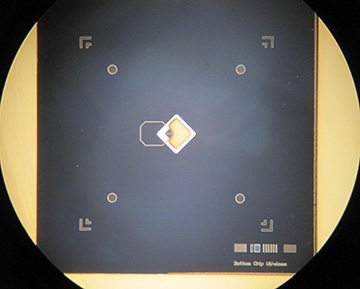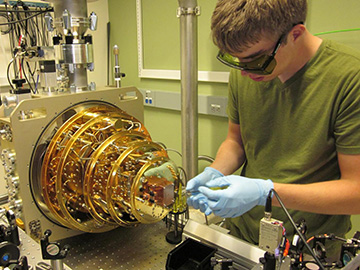
A new chip, designed by JILA researchers and measuring less than a half-inch across, converts microwave energy into laser light. [Image: Peter Burns and Dan Schmidt]
The vision of a future quantum internet involves networks of quantum computers linked together over long distances. That requires entanglement of spatially separated quantum nodes, to permit secure communication and distributed quantum computing.
Researchers at JILA, a joint institute of University of Colorado, Boulder, and the U.S. National Institute of Standards and Technology (NIST), have developed a mechanical device that could help make this possible. The device converts the microwave-frequency output of superconducting quantum processors to the optical frequencies used to transmit entangled photons through kilometers of optical fiber (Nat. Phys., doi: 10.1038/s41567-018-0210-0).
Efficient microwave-to-optical conversion
The key physical part of the team’s microwave-to-optical converter is a suspended dielectric membrane with a single vibrational mode that’s coupled simultaneously to both a microwave and an optical cavity. It operates at 47 percent efficiency—much better, according to the researchers, than other methods for converting microwaves into light, such as those using crystals or magnets.
Besides its efficiency, though, the noise added by the converter is an important factor in determining the device’s potential for quantum operation. The JILA micromechanical device operates at temperatures below 100 mK, to meet the ultralow temperature needs of prototype quantum chips currently under development at companies like Google and Intel. Even at these low temperatures, however, small amounts of heat can make the membrane shake, generating photons that contaminate the signal.
Hammering down noise

Robert Peterson, a former JILA graduate student, works with a “dilution refrigerator,” used to cool instruments like the lab’s microwave-to-optical quantum converter down to a fraction of a degree above absolute zero. [Image: Peter Burns]
The researchers found an end run around this potential noise problem, through a feed-forward protocol. They realized that the noise emitted from the converter’s input/output ports is strongly correlated, because the thermal motion of the single mechanical mode affects both sides of the device. That means that a microwave signal that is upconverted and retrieved at the optical port, has the same noise added to it as a reference signal injected at the optical port and travelling in reverse through the device at the same time. As a result, it’s possible to retrieve and measure the downconverted reference signal at the microwave port and use it to remove the correlated noise from the upconverted optical mode.
Careful choice of the reference signal determines whether the feed-forward protocol is appropriate for quantum tasks. Classical feed-forward is useful for recovering signals that depend on system efficiencies, whereas quantum feed-forward is required in cases where there is thermal noise.
The authors determined that, in an otherwise perfect system with no measurement losses or reflections, a converter efficiency of more than 50 percent is required for quantum operation, because any losses add noise to the feed-forward process. Given high system efficiencies, however, they showed that transfer of quantum information could be possible even when thermal phonons enter the mechanical element faster than the electro-optic conversion rate.
Using classical feed-forward, the authors conducted an experiment where they managed to reduce added noise to 38 photons. A previously reported prototype device, by comparison, operated at 4 K with 8 percent efficiency and with 1,500 added photons.
Networking potential
Before the converter can become a practical tool, the team needs to reduce the noise even further. Still, the researchers are excited about the networking potential of their discovery.
In a press release accompanying the work, co-author Konrad Lehnert said “It's clear that we are moving toward a future where we will have little prototype quantum computers. It will be a huge benefit if we can network them together.” Connecting smaller chips is an obvious way to increase the processing power of prototype quantum computers, and this proposed quantum-compatible link between the microwave and optical domains could help achieve that.
